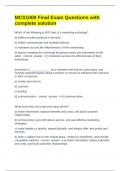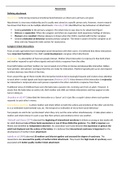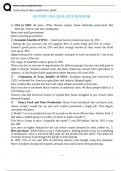Locomotion
❗ Succesfull human locomotion:
1. Brain stem: postural control to support the body against Fz.
2. Spinal cord: basic locomotor pattern/rythm which moves the body in the
desired direction.
3. Supraspinal level & peripheral efference: adaptable to the needs of the
individual and the demands of the environment.
Characteristics for locomotion
1. Stability: balance control
2. Propulsion of the body in the intended direction.
3. Adaptation to potentially destabilising factors in an anticipatory way.
= predictive reaction for a movement that is going to happen.
4. Dual tasking: Combinations with other movement
Relate them to standing phase and swinging phase:
Locomotion 1
, Gait cycle
❗ Single limb gait cycle = stands phase (60%) & swing phase (40%).
Problems in post-stroke gait cycle:
1. Heel strike:
Not able to put heel first.
2. Loading response = changing the loading from one leg to the other.
Insufficient loading: not able to move the body to the hemiplegic side.
Difficulty going in hip extension.
→ Hip stays in flexion and the knee will go in hyperextension.
3. Midstance: standing on one leg.
Can not stand on hemiplegic leg.
→ This phase will go fast.
4. Terminal stance = loading going to the end of the foot.
No extension of the hip.
Lifting the heel is hard.
5. Pre swing phase = two feet supported and shift the load.
No push off but rather pull off.
6. Initial & mid swing:
Circumduction of the hip.
Knee is hard to get from flexion to extension.
No dorsiflexion in the foot.
7. Terminal swing:
Foot clearance is difficult.
Locomotion 2
, Central pattern generators (=CPG)
❗ = networks of nerve cells that generate movement & contains the
information necessary to activate different motor neurons in the
appropriate sequence and intensity to generate motor patterns.
Walking is controlled by the flexible combination of 4 to 5 CPGs.
❗ Basic walking pattern can be produces by CPGs alone but for the
skilles and context dependent adaptations:
1. Supraspinal: for the goal.
2. Peripheral afferents: e.g. surface info.
1. Four limb coordination.
❗ Using the arms are more cortical level than spinal.
2. Normal hip joint loading to trigger extensor muscle.
3. Hip extension to trigger swing phase.
4. Normal activity levels and loading.
5. Cutaneous afferents to signal when adaptations are necessary for obstacle
avoidance or uneven surface.
Applying CPGs to walking with a stick:
1. No 4 limb coordination.
2. Loading reduces.
3. N/A.
4. muscle activity reduced.
5. Confusing cutaneous info: collision between cane and foot.
Locomotion 3
❗ Succesfull human locomotion:
1. Brain stem: postural control to support the body against Fz.
2. Spinal cord: basic locomotor pattern/rythm which moves the body in the
desired direction.
3. Supraspinal level & peripheral efference: adaptable to the needs of the
individual and the demands of the environment.
Characteristics for locomotion
1. Stability: balance control
2. Propulsion of the body in the intended direction.
3. Adaptation to potentially destabilising factors in an anticipatory way.
= predictive reaction for a movement that is going to happen.
4. Dual tasking: Combinations with other movement
Relate them to standing phase and swinging phase:
Locomotion 1
, Gait cycle
❗ Single limb gait cycle = stands phase (60%) & swing phase (40%).
Problems in post-stroke gait cycle:
1. Heel strike:
Not able to put heel first.
2. Loading response = changing the loading from one leg to the other.
Insufficient loading: not able to move the body to the hemiplegic side.
Difficulty going in hip extension.
→ Hip stays in flexion and the knee will go in hyperextension.
3. Midstance: standing on one leg.
Can not stand on hemiplegic leg.
→ This phase will go fast.
4. Terminal stance = loading going to the end of the foot.
No extension of the hip.
Lifting the heel is hard.
5. Pre swing phase = two feet supported and shift the load.
No push off but rather pull off.
6. Initial & mid swing:
Circumduction of the hip.
Knee is hard to get from flexion to extension.
No dorsiflexion in the foot.
7. Terminal swing:
Foot clearance is difficult.
Locomotion 2
, Central pattern generators (=CPG)
❗ = networks of nerve cells that generate movement & contains the
information necessary to activate different motor neurons in the
appropriate sequence and intensity to generate motor patterns.
Walking is controlled by the flexible combination of 4 to 5 CPGs.
❗ Basic walking pattern can be produces by CPGs alone but for the
skilles and context dependent adaptations:
1. Supraspinal: for the goal.
2. Peripheral afferents: e.g. surface info.
1. Four limb coordination.
❗ Using the arms are more cortical level than spinal.
2. Normal hip joint loading to trigger extensor muscle.
3. Hip extension to trigger swing phase.
4. Normal activity levels and loading.
5. Cutaneous afferents to signal when adaptations are necessary for obstacle
avoidance or uneven surface.
Applying CPGs to walking with a stick:
1. No 4 limb coordination.
2. Loading reduces.
3. N/A.
4. muscle activity reduced.
5. Confusing cutaneous info: collision between cane and foot.
Locomotion 3







